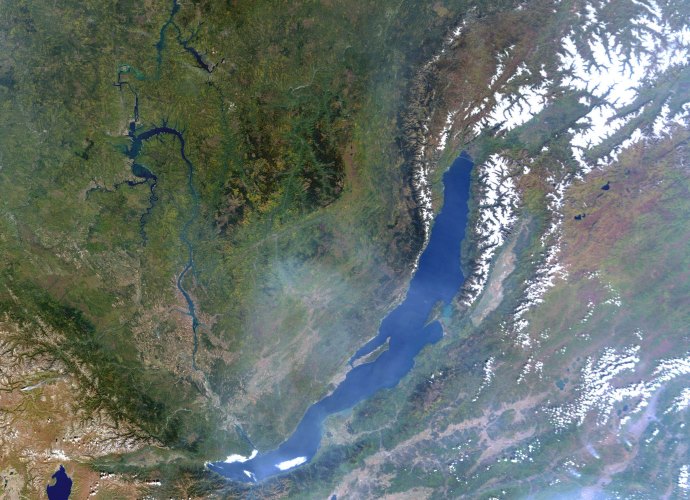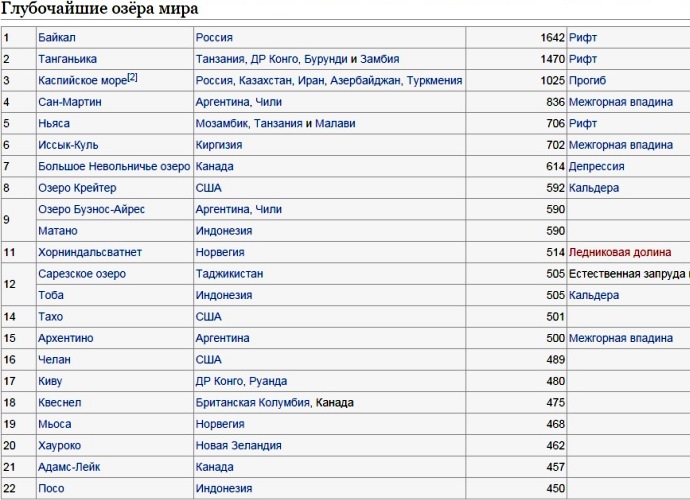12.09.2010
Lake Baikal is the deepest and cleanest lake on the planet
On September 12, a regional holiday was celebrated in the Irkutsk region - the Day of Baikal. Exhibitions, quizzes, drawing contests, theatrical performances, ecological games will be dedicated to the unique lake.
The organizers of the events set themselves the task of instilling in the Irkutsk people a culture of recreation on the shores of the lake, drawing public attention to the need to respect the unique natural monument.
"Holy Sea", " holy lake"," Holy water "- this is how Baikal was called from time immemorial by the indigenous people, the Russians who came to its shores in the 17th century, and the traveling foreigners, admiring its majestic beauty.
Baikal is the deepest lake in the world. Its average depth is about 730 m. For the first time, it was accurately calculated by Gleb Vereshchagin in the 1930s. The greatest known depth of Lake Baikal is 1637 m.
The area of the water surface of Lake Baikal is 31.5 thousand square meters. km - this is approximately equal to the area of countries such as Belgium, the Netherlands or Denmark. In terms of the area of the water surface, Baikal ranks eighth among the largest lakes in the world.
Baikal contains about 1/5 of the world's reserves surface waters Lands (excluding the ice of Antarctica, Greenland, and other glaciers), and more than 4/5 of Russia's fresh water reserves.
Each year the lake produces 60 cubic meters. km of clean, biologically active water. Through the Angara, this water enters the World Ocean.
According to the head of the International Fund "Baikal - World Heritage" Larisa Kokhova, "harmonizing the World Ocean is one of the purposes of Baikal." She believes that scientists-limnologists look into the depths of the Baikal "eye", as iridologists look into the human eye, and receive information about what is happening in the waters of the earth.
From space, the relief of the Baikal bottom is visible to a depth of 500 meters. It is also the most transparent lake in the world, which can only be compared with the Sargasso Sea. "Disk of Sepka", the standard of water transparency, is visible in different places Baikal at a depth of 40-45 m.
The secret of the Baikal phenomenon of purity is the tiny endemic crustacean Epishura, a miniature relative of the shrimp. Every year this "orderly" filters the half-meter surface layer of water, processing all dead organic matter, and also providing water with oxygen.
On December 5, 1996, at the 20th session of the UNESCO World Heritage Committee, held in the Mexican city of Merida, Baikal was included in the List natural heritage UNESCO.
The unique ecosystem of Lake Baikal is home to more than 2630 species of flora and fauna. Most are endemic.
The only mammal that lives in Lake Baikal is the Baikal seal. Adult seals reach a length of 1.8 m and a weight of 130 kg. The seal lives up to 55 - 56 years.
There are 236 bird species on Lake Baikal.
There are 58 fish species in the lake. The most famous are omul, whitefish, grayling, taimen, sturgeon, golomyanka, lenok.
The ecological state of the largest freshwater lake on the planet in the previous decades caused great concern among Russian and international environmental organizations. The main threat to the lake was considered the Baikal Pulp and Paper Mill, launched in 1966, which in September 2008, at the request of the Ministry of Natural Resources of the Russian Federation, switched to a closed cycle of water circulation.
According to scientists, the shutdown of the BPPM had a positive effect on the ecosystem of Lake Baikal. However, in January 2010, the Russian government excluded the production of cellulose, paper and cardboard from the list of activities prohibited in the central ecological zone of the Baikal natural area, which opened the way for the resumption of the plant's work. In May, the mill produced a trial batch of bleached viscose cellulose in the framework of an open water cycle. Since the beginning of July 2010, the BPPM resumed its operations after one and a half years of downtime.
Baikal Day was established in 1999 at the initiative of public environmental organizations of the Irkutsk region, the Republic of Buryatia and Trans-Baikal Territory after the lake, containing a fifth of the planet's fresh water reserves, was awarded the status of a UNESCO World Natural Heritage Site.
Baikal: a pearl of tourism or a lake for industrial wastewater?
Baikal Day, celebrated every second Sunday in September, draws attention to the deepest lake on Earth, which conceals the mystery of "Kolchak's gold", and scientific discoveries the future, and the environmental problem of the present - a working pulp and paper mill. Will the Russian authorities keep their promise and close the BPPM in 30 months to turn the lake into a tourist pearl of Siberia?
CELLULOSE WASTE
The purity of the largest natural reservoir of fresh water is polluted by the Baikal Pulp and Paper Mill (BPPM), which, having received permission from the government of the Russian Federation in January 2010, resumed cellulose production after a year and a half of downtime.
In October 2008, the enterprise stopped because it was prohibited from dumping industrial wastewater into Lake Baikal and from using chlorine in pulp bleaching. After the introduction of this ban, the mill could only work with a closed water circulation system, in which the production of highly profitable bleached cellulose is impossible.
However, in January, the Russian government excluded the production of cellulose, paper and cardboard from the list of activities prohibited in the central ecological zone of the Baikal natural territory, which opened the way for the reopening of the mill. In January, BPPM began testing equipment and produced several trial batches of unbleached pulp in a closed water cycle. In May, the mill produced the first batch of bleached viscose cellulose within the framework of an open water cycle.
An unscheduled inspection of the West Baikal environmental prosecutor's office carried out in July showed that the Baikal PPM discharges pollutants into Lake Baikal in volumes exceeding the maximum permissible concentrations. These checks showed an excess of concentration for phenol by 68 times, for turpentine - 1.2 times, for oil products - 1.5 times, for lignin - 3-15 times, for tallow products - 6 times.
Meanwhile, the BPPM is only going to increase production. According to Nikolay Makarov, chairman of the board of directors of Continentalinvest, which controls the mill, in the first quarter of 2011, BPPM plans to launch a second stream of pulping.
ANOTHER 30 MONTHS
Discharge of drains occurs directly into the object world heritage UNESCO, which Baikal became in 1996. Therefore, the issue of pollution of Lake Baikal was brought up to the international level - at the 34th session of UNESCO in Brazil in July-August 2010.
The Russian delegation at the session promised that the problem of pollution of Lake Baikal by discharges from the Baikal Pulp and Paper Mill will be resolved within 30 months. The solution of the BPPM problem, according to the Russian delegation, implies either the closure of the plant with a conversion to an alternative safe production, or the introduction of a closed water circulation.
In turn, the UNESCO World Heritage Committee stated that it is urgent to develop effective scenarios for solving the problem, and to submit a report by February 1, 2011, which should present the steps taken by Russia to stop the pollution of Baikal by the BPPM, as well as to reduce the pollution of the lake by the Selenga River. ...
Meanwhile, as noted by environmentalists, the promise to solve the problem in 30 months, made by the Russian delegation, is not legally binding and can be forgotten and violated.
“The government should include the specified period of 30 months in the text of the resolution and thereby demonstrate the seriousness of its intentions to fulfill the country's obligations to stop the pollution of the lake by the Baikal Pulp and Paper Mill,” says Evgeny Shvarts, Director for Environmental Policy of the World Wildlife Fund (WWF) Russia.
For 30 months, according to official data, 112.5 million cubic meters of wastewater will be discharged into Baikal.
FTP INSTEAD OF PPM
At the Baikal Economic Forum held on September 7-10, the federal target program (FTP) "Protection of Lake Baikal and the socio-economic development of the Baikal natural territory in 2011-2020" was presented. In particular, the program provides for the disposal and recycling of accumulated industrial waste and alternative socio-economic development of the region.
The FTP is aimed at reducing the discharge of pollutants into the water bodies of the Baikal territory, reducing the level of pollution with waste, increasing the efficiency of using the recreational potential of the lake, preserving endangered flora and fauna, developing a system for protecting coastlines of the natural territory and a system of state environmental monitoring.
Meanwhile, the coalition of public and environmental organizations "For Baikal!" believes that the main thing is not indicated in the program - the intention to close the BPPM.
PEARL OF TOURISM
In connection with the problem of the BPPM, the target program should also contain a section dedicated to supporting small and medium-sized businesses and measures to develop tourism, ecologists say.
"The creation of special economic zones for tourism and recreation ... with the imposition of increased environmental requirements ... will allow attracting private investors to the Baikal region and diversifying the economy of the Baikal natural territory and employment of the population," the statement of the coalition For Baikal! ".
Moreover, there are already examples of diversification. The Italian project company Plan Team presented in August a concept for the development of two key sections of the Baikal Harbor, a tourist special economic zone (SEZ), developed by order of the Buryat government.
In particular, it is planned to build ski resort for 10 thousand tourists. And the resort "Bezymyannaya Bukhta", according to the concept, is a major tourist center for family vacation, adventure lovers and aquatic species sports on the shores of Lake Baikal, which will accommodate up to 2.5 thousand people. It is assumed that the construction of facilities on two sections of the SEZ will begin no earlier than 2012.
In Baikalsk itself, the plant, according to ecologists, hinders the development of ski tourism on Mount Sobolinaya. “In 2008, when the Baikal Pulp and Paper Mill stood up, there were more tourists than usual, despite the harsh winter with low temperatures. People came to Baikalsk, having learned that there is no BPPM, there is no bad smell over the city, ”says Roman Vazhenkov, head of the Baikal program of Greenpeace Russia.
Although tourism alone may not be enough for the economy of the region to completely replace the BPPM. In 2009, the Siberian Branch of the Russian Academy of Sciences, together with High school economy proposed to develop industrial projects that can be based on those natural resources, which are available in the south of Baikal. Thus, the workshops of the plant are suitable for the production of ready-made wooden houses. This project, according to the authors, could pay off within 3-5 years even in a financial crisis.
Such economic projects, together with the development of the tourism business in the special economic zone, could create new places of employment for the population of Baikalsk so that the employees of the plant would not be left on the street after its closure, Vazhenkov said.
GAS HYDRATES AND RING
Meanwhile, the lake, which is shrouded in many legends and mysteries, continues to attract researchers. The research expedition "Worlds on Baikal" has been taking place since 2008: scientists on two deep-sea manned vehicles (GOA) "Mir-1" and "Mir-2" are investigating the state of the ecosystem of the reservoir, flora and fauna, tectonic processes at the bottom of the lake.
Within the framework of diving to the maximum marks of the bottom of the lake, an investigation of the animal and flora, study of the places of emergence of underwater hydrothermal fluids and mud volcanoes, determination of gas hydrate reserves, examination of the places of discharge of hydrocarbons and their background level to assess water pollution and predict hydrocarbon emissions. The data on the depths of Lake Baikal, on tectonic processes at the bottom of the lake, the state of coastline lakes. One of the most interesting parts of the expedition is the search for archaeological artifacts.
At the end of a series of dives in 2009 in the area of the Circum-Baikal railroad scientists have found fragments of a railway carriage, as well as boxes of cartridges from the times Civil war... The researchers suggested that this could be the train on which the white admiral Kolchak was taking out the gold of the empire. This year, during final dives in the same area, scientists found objects that outwardly resemble gold bars, but they failed to raise the find to the surface.
A LAKE OF EXCELLENT DEGREES
Baikal is one of the greatest lakes on the planet, a lake of "superlatives": the deepest (1637 m), the oldest (about 25 million years), with the most diverse flora and fauna among fresh water bodies. The lake has a unique in terms of volume and quality reserve of fresh water (23.6 thousand cubic km - more than 20% of the world's reserves). The Baikal depression is the central link of the Baikal rift zone, one of the largest on Earth ancient system faults. The lake, together with its entire basin, is a peculiar and very fragile natural ecosystem, which ensures the natural process of the formation of the purest waters.
For Siberia, the climate of the Baikal coasts is relatively mild. For example, the number of sunny days per year is higher here than in many Black Sea resorts.
The hollow of the lake, along with the framing it mountain systems- the most important natural boundary of Siberia, in this area the boundaries of various floristic and faunistic complexes converge, biogeocenoses that have no analogues are presented here. One of the richest and most unusual freshwater fauna in the world, which is of exceptional value for the study of evolutionary processes, has been formed in the ancient isolated Baikal depression.
Of the more than 2,630 thousand species and subspecies of animals and plants found so far in the lake, more than 80% are found nowhere else in the world. Who has not heard of the famous Baikal omul or the Baikal sturgeon? Two unique species of viviparous fish, representatives of a family endemic to Lake Baikal, - large and small golomyanka - are known to ichthyologists all over the world. The pyramid of the lake ecosystem is crowned with a mammal of a typical marine origin - the seal, or the Baikal seal.
On South Eastern Siberia, where the Irkutsk region borders with Buryatia, is one of the seven wonders of the world - the largest and deepest fresh water body in the world - Lake Baikal. Locals are accustomed to calling it the sea, because its opposite shore in many places is out of sight. It is the largest reservoir of fresh water on the planet with an area of more than 31 thousand km², which would fully accommodate the Netherlands and Belgium, and the maximum depth of Lake Baikal is 1642 m.
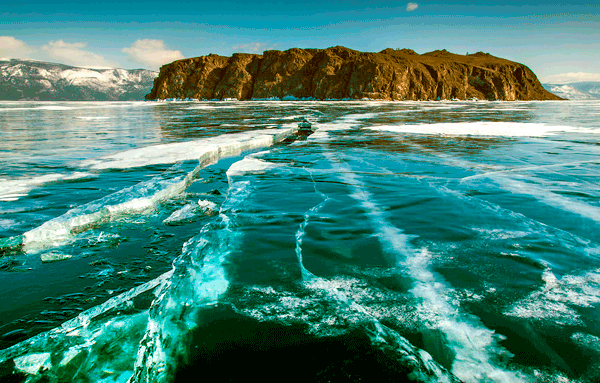
Lake record holder
The crescent-shaped reservoir has a record length of 620 km, and the width in different places ranges from 24-79 km. The lake lies in a basin with tectonic origin, therefore, its relief bottom is very deep - 1176 m below the level of the World Ocean, and the water surface rises 456 m above it. The average depth is 745 m. The bottom is extremely picturesque - various banks, in other words, ancient shoals, terraces, caves, reefs and canyons, plumes, ridges and plains. It consists of great variety natural materials, including limestone and marble.
Above, we wrote what the depth of Lake Baikal is, and according to this indicator it is in first place on the planet. The African Tanganyika (1470 m) ranks second after Lake Baikal, and the Caspian (1025 m) - closes the top three. The depth of other reservoirs is less than 1000 m. Baikal is a storage of fresh water, it is 20% of the world's reserves and 90% of Russia's reserves. For example, the tonnage of its water reserves is greater than in the entire system of the five Great Lakes of the United States - Huron, Michigan, Erie, Ontario and Superior. But largest lake After all, it is not Baikal that is considered Europe (it ranks 7th in the world ranking), but Ladoga, this lake occupies 17,100 km². Some people try to compare the famous fresh water bodies in Russia and are interested in which lake is still deeper - Baikal or Ladoga, although there is nothing to think about, since the average depth of Ladoga is only 50 m.
Interesting fact: Baikal receives 336 large and small rivers, and releases only one from its embrace - the beautiful Angara.
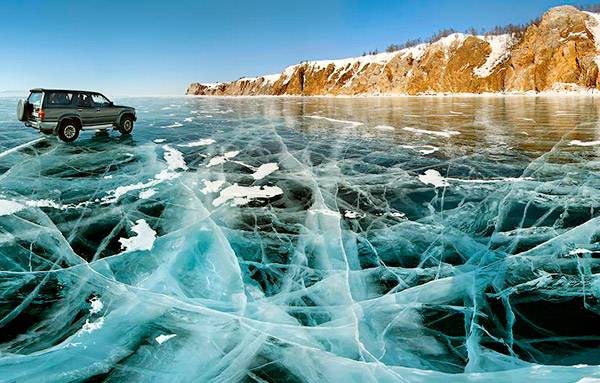
In winter, the lake freezes to a depth of about a meter, and many tourists come to admire the exceptional spectacle - a completely transparent ice "floor", under which the sun-penetrated blue and green water splashes. The upper layers of ice are transformed into intricate shapes and blocks, hewn by winds, currents and weather.

The famous Baikal water
Lake water was deified in ancient times local residents, they treated her and worshiped her. It has been proven that the water of Lake Baikal has unique properties - it is saturated with oxygen and is practically distilled, and due to the presence of various microorganisms it is devoid of minerals. In addition, it is famous all over the world for its exceptional transparency, especially in spring, when stones lying at a depth of 40 m are beautifully visible from the surface, but in summer, during the flowering period, visibility decreases to 10 m. The waters of Lake Baikal are changeable: they change their color from deep blue to deep green, it is the smallest life forms that develop and give the reservoir new shades.
Depth indicators of Baikal
In 1960, researchers measured the depth near the Izhemey and Khara-Khushun capes with a cable lot and documented the most deep place Baikal at that time - 1620 m.Two decades later, in 1983, the expedition led by A. Sulimanov and L. Kolotilo corrected the indicators in this area using the echo sounding method and recorded new data - the deepest point was at a depth of 1642 m. Further 20 years later, in 2002, an international expedition under the auspices of a joint project of Russia, Spain and Belgium worked on the creation of a modern bathymetric map of Lake Baikal and confirmed the latest measurements using acoustic sounding of the bottom.
The unique reservoir at all times attracted increased attention of scientists and researchers, who equipped all new expeditions in order to clarify the previous measurements of depth in different parts of the reservoir. So, in 2008-2010 expeditions of GOA "Mir" organized about 200 dives throughout the water area of this fresh sea... They were attended by prominent politicians and businessmen, journalists, athletes and hydronauts from Western and of Eastern Europe and Russia.
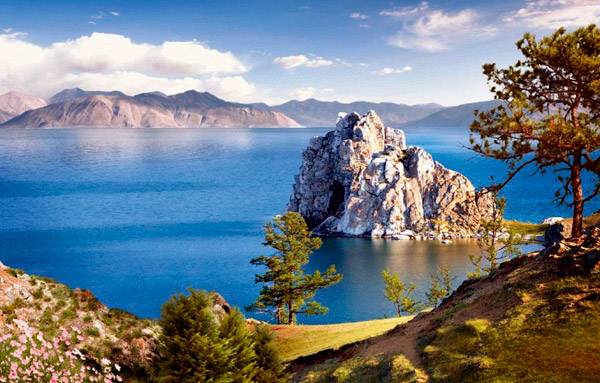
Where are the deepest places of Baikal
Since the bottom of the reservoir is heavily riddled with faults, the depth of the lake in different parts of the water area is different:
- at western shores the deepest breaks in the earth's crust lie;
- in the southern part, the record depth of the depression between the mouths of the Peremnaya and Mishikha rivers was recorded at 1432 m;
- in the north, the deepest place is located between capes Elokhin and Pokoiniki - 890 m;
- deep depressions in the Small Sea - up to 259 m, their location at the Big Olkhon Gate;
- the greatest depth of Baikal in the Barguzinsky Bay area reaches 1284 m, this point is located at southern shores Peninsula Holy Nose.
Video: an interesting film about Lake Baikal
This unique ecosystem attracts scientists and researchers from all over the world. Thousands of tourists from all over the world travel to the deepest lake in the world to enjoy the splendor of its landscapes, landscapes that you will not find anywhere else. The endless variety of flora and fauna of the region, among which are mainly endemic (found only here), complements the richness given to people by nature.
They belong to the largest lakes in the world by area.
Ladoga lake the largest lake in terms of area. The lake is more than 200 km long with an average width of 80 km. The length of its coastline is about 1800 km, that is, 3 times more than the distance between Moscow and. The greatest depth of the lake exceeds 200 m. The shores of the lake are very diverse. The northern one is rocky, cultivated, all cut by narrow bays that protrude far into the land. The rest are mostly low and gentle. The lake has more than 600 islands. Most of them are located off the north coast. The largest of them are Riekkalansari, Mantsinsari, Kilpola, and Valaam. The latter, although the smallest of them, has long become the most famous thanks to the famous Valaam (Preobrazhensky) Monastery, which for some time was one of the Russian fortresses. In winter, the lake freezes over, and not immediately, but gradually. Winds crack open areas, turning them into chaos from a mixture of supercooled water and broken ice... The ice on the lake is uneven, hilly, hummocky. The height of ice hummocks in some places reaches the height of a five-story building. The lake is released from the ice captivity in the first ten days of May. A small part of the broken ice is carried out of the lake by the Neva River into The Gulf of Finland... The lake is also famous for its winds. Severe storms also happen. Not without reason, according to the conditions of navigation, Lake Ladoga is equated to the seas. It is used by ships of class "M" - sea.
Lake Onega is the second largest lake in Europe after Ladoga Lake. Compared to Ladoga, its area is about 2 times smaller, but at the same time it is 50 km longer. The lake has a bizarre shape and resembles an unknown monster with several tentacles, one of which resembles a trunk, and the other a crayfish claw. One of the interpretations of the name of the lake states that the word "onego" in the Old Finnish language means "smoking lake". This name appeared from the frequent, creeping over the lake. And Ladoga is related not only by the fact that they are the largest in Europe and are located close to each other. The main thing is that they appeared almost simultaneously, after the retreat of the last glaciers. Large tectonic depressions occupied by lake depressions existed in pre-glacial times. The advancing glaciers plowed out the bottoms of the lake basins, making them smoother, and worked on the coastal rocks. Thus, according to the method of origin of the basins, the lakes are classified as glacial-tectonic. Within Lake Onega there are more than one and a half thousand islands. The shores of most of them are indented by bays and coves, and they themselves are covered with dense. The largest of them are Klimetskiy and Suisari. The most famous - Kizhi - is famous for its wooden monuments of folk architecture. Numerous rivers fill the lake with water. Among them are Shuya, Suna, Andoma, Vytegra. The level of the lake depends on how much water the rivers bring to the basin of the lake. In spring, when the snow melts, the tributaries become abundant and intensively feed the lake. Its level is rising. By the middle of summer, the water level gradually decreases.
![]()
Peipsi-Pskov lake
It is the third largest in Europe. Its basin is of glacial origin. The retreating glacier left behind a mass of unsorted material - as a result of which a special, hilly-moraine appeared. Depressions in the relief are usually occupied by lakes. Usually these are small and shallow lakes, bizarre in shape, with low, often swampy shores. The lake is waste water. The Narva River flows out of it.
Lake Taimyr
Lake Taimyr is the largest in the north of Siberia. It is shallow. The prevailing depths are about 4 meters. The lake is covered with ice for about nine months a year. Moreover, most of it freezes to the bottom. The lake feeds on melt water brought by rivers. The seasonal rise in water level occurs at the end of June. In spring, the water in the lake is cloudy, but by the end of summer it becomes transparent.
Lake Baikal
Baikal is one of the most amazing natural sites on our planet. This is the deepest, the largest in terms of volume of fresh water, and the most unique in terms of the uniqueness of the organic world. There is no other such large body of water on Earth, so far from the ocean. The basin of the lake has a tectonic origin, as evidenced by its elongated shape. The maximum length of the lake is 636 km, and the length of the coastline is 2500 km. The area occupied by Lake Baikal (31.5 thousand sq. Km) could accommodate such a state as. Maximum depth lakes - 1940 m. Water volume - 23 thousand cubic meters. km - contains about the same amount of water. A huge mass of water keeps warm for a long time and does not freeze for a long time. In December, and sometimes in January, individual ice floes still roam the lake. The lake opens up in mid-May. The thickness of the ice by this time reaches one meter. In summer, Baikal is harsh and angry. Winds and storms cause a lot of trouble for ship captains and fishermen. Each of the winds has its own name: Barguzin, Kultuk, Gloss, Sarma, Siver, Shelonnik, etc. Baikal surpasses in the number of stormy days. The height of the waves during a storm can reach 4 meters. There are legends about Baikal water. Nowhere in the world is there such soft, chemically pure, oxygen-rich and healthy water. The following fact is interesting: the water in Baikal is more fresh than the water of the rivers and rivulets flowing into it. Each liter contains less than 0.1 g of dissolved minerals - calcium, magnesium, silicon. Due to the small amount of impurities, the water in Lake Baikal is the most transparent in the world. The white disc used to determine the transparency of water is visible to a depth of 40-45 meters. For comparison, note that it disappears from the field of view when submerged to 10 meters, in Sevan - 20 meters, in the Caspian - 25 meters. In terms of the diversity of the organic world, Baikal can compete with tropical seas. More than 2.5 thousand species of animals and plants live in the lake. Moreover, about 2/3 of them are found nowhere else. Unique organic world contributes to the preservation of the purity of Baikal waters. Tiny crustaceans Epishura filter water through the mesh of their antennae and catch organisms that cause water “bloom”. Diatoms extract silicon from the water and build their graceful shells from it. Scientists estimate that algae take 400-500 thousand tons of silicon annually.
Forming the southern part of its basin, give reason to believe. In terms of its area, depth, and water volume, the Caspian Sea is quite comparable to such seas as Black and Yellow. The natural resources of the reservoir have long attracted many peoples here. Cimmerians, Cumans, Scythians, Sarmatians, Arabs, Turks, Persians, Khazars and many other peoples lived here. Ancient trade routes ran along the Caspian Sea. The migration of peoples and trade took place along them. Each of the peoples named the Caspian in its own way. The ancient Greeks called it the Hyrcanian or Persian Sea, the Assyrians - the Eastern, the Chinese - the Western. Among the Arabs, it was known under the name of the Khorosan or Khozar Sea; the Tatars called him Ak-Dengiz (). In ancient Russian chronicles, the Caspian Sea was called Khvalynsky or Derbent. Among the many names, one has survived - the modern one. It comes from the disappeared people - the Caspians (horse breeders) who once lived on its banks. The sea feeds the most big river Europe -. In addition to it, the Urals, Emba, Terek, and Kura bring their waters to the Caspian. The water level in the Caspian Sea is subject to large and long-term fluctuations. And although this feature was noticed in ancient times, the reasons for this have not been fully clarified. At present, the water level in the Caspian is 27.5 meters below the level of the World Ocean.
Lakes, like reservoirs, are scattered all over the planet. Sometimes the scale of such natural zones is surprising, especially when it comes to size, and, of course, the deepest lake in the world- Baikal requires attention. It is not necessary to be a desperate traveler or an extreme lover to explore this world, especially since you can do this today without getting up from your own couch.
The deepest lake in the world
Among the list of the largest lakes, choosing the deepest is easy. Leading positions in the list answering the question, what is the deepest lake in the world, occupy two reservoirs: Baikal and, according to some assumptions, Lake Ladoga. It is possible to determine the maximum depth of these natural zones based on mathematical research, the results of which are even available in encyclopedias. So, the maximum depth of Lake Baikal is 1642 meters, and Lake Ladoga is 230 meters. After evaluating these data, the conclusion is involuntarily imposed that the deepest lake in the world- this is Baikal.

The deepest lake in the world, Ladoga? ...
Lake Ladoga is located in Russia, on the territory of the Republic of Karelia. And today on the Internet you can find information that supposedly the deepest lake in the world - Ladoga... The information is wrong! Unfortunately, this water reservoir cannot be compared in its depth with Lake Baikal.

However, for some reason, many stubbornly believe that it is these water spaces (Lake Ladoga) that store the maximum existing depth under their surface, in comparison with similar bodies of water. Lake Ladoga really has several places where the depth corresponds to impressive parameters. Experts define more than ten of these, although the maximum depth is 230 meters, and this is not enough for a record. And even if we compare it with other bodies of water, such as, for example, the Caspian Sea, then Ladoga is simply "knee-deep" ...

The deepest lake in the world Baikal
Lake Baikal is familiar to many Russians firsthand. Such natural area famous for its virgin beauty, excellent fishing and unforgettable vacation... Moreover, you can spend your leisure time here either alone or in a noisy company. Under its smooth surface the deepest lake in the world Baikal keeps a lot of surprises, and no one knows what is there, in the abyss of the lake. Located the deepest lake in the world in a beautiful area, in the eastern part of Siberia, it is the largest reservoir of fresh and purest water.
Read our portal about tourism and travel and you will find out which one. And many more useful and, undoubtedly, interesting ...
- Country Russia
Water has always acted on a person not only bewitching, but also soothing. People came to her and talked about their sorrows, in her calm waters they found special peace and harmony. That is why the numerous lakes of Russia are so remarkable!
The beauty and charm of the water surface
The calm mirror-like surface is stagnant water, surrounded on all sides by the banks. It is also a place of admiration, aesthetic pleasure. What are lakes like? They can be deep (sometimes deeper than the seas) and shallow, fresh and salty, large in area and small, of volcanic, tectonic, moraine origin. Their ages also vary. There are no ugly or boring ones, the map shows that there are an infinite number of them, and each of them is beautiful and perfect in its own way.
Surely any traveler who has visited this country at least once, or a resident, will find his favorite or even sacred lake... In any case, a visit to them is highly recommended. Once you see Lake Baikal or Lake Teletskoye, you will fall in love with it once and for all! This is the place of power that fills with energy after working years, stifling city air and long social contact. It is important not only to contemplate beauty with awe, but also to protect it.
Deep abyss of Baikal
What is the most of Russia? Of course, this is the mysterious and unique Baikal! Even any schoolboy has heard of him. This is just a magical and unique place with pure, pure water, which always has a deep blue hue. If there is not a cloud in the sky, then the surface of the water becomes simply emerald! The deep lake is of high ecological value and is included in the UNESCO list. The water here is fresh, and the depth reaches 1642 meters, which makes it possible to compare it with the depths of the Arctic Ocean (depth 1220 meters). If suddenly there is not left, then the deepest lake in Russia will be able to quench the thirst of the population of the whole world for 50 years, since it makes up a fifth of all reserves.
It is considered the oldest lake. Think for yourself - its age is 25 million years! Its depth is due to a large crack in earth crust... The continental depression is gradually increasing. Olkhon Island, which stretches for 71 kilometers, remains the largest here. It divides Baikal into Small ( Eastern) and the Big Sea ( Western part).
The waters are crystal clear, so you can see 40 meters deep, which allows you to distinguish the local deep-sea inhabitants. The water temperature is usually around +8 degrees Celsius. Baikal is also famous for its hot springs. Two large cities that are located near its waters are Irkutsk and Ulan-Ude. It is not entirely serene near the calm surface of the lake. Earthquakes, small and large, happen here all the time.
Pearl of Karelia - Lake Onega
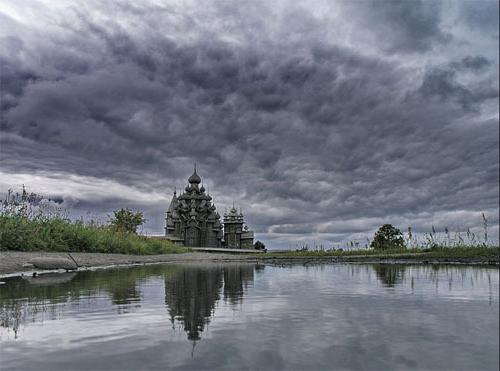
Baikal is the most a nice place, but there are also other lakes of Russia that captivate travelers with their mystery. Onega belongs to them. They even began to call it the sea, since it is the second largest in Europe after Ladoga. The length of the lake is 245 kilometers, the maximum depth is 130 meters. Since the time of the distant ice age, many local inhabitants have remained here - fish and amphibians. This place is a treasure trove for fishing enthusiasts. The northern area is ideal for valuable fish species: trout, salmon, sterlet.
Lake Peipsi - the greatness of the dunes
Where is another of the largest and most beautiful lakes? In the northern regions, like most others. Lake Peipsi is located near Latvia and Estonia. It separates these two countries from the Pskov region. The longest is 90 kilometers and the width is 47 kilometers. The lake is constantly replenished with water from many rivers and large streams. What are the remarkable shores Lake Peipsi from the north side? They are a continuous chain of dunes that stretch into the distance. Their height is quite impressive - about eight, and in some places all 10 meters. Closer to the west, the dunes become flatter. The south side is Finnish granite boulders.
There is also an islet lost in the brilliant water surface. It is located in the south of the lake and has the name "Zhelachek" ("Mezha"). There are also two small villages on it.
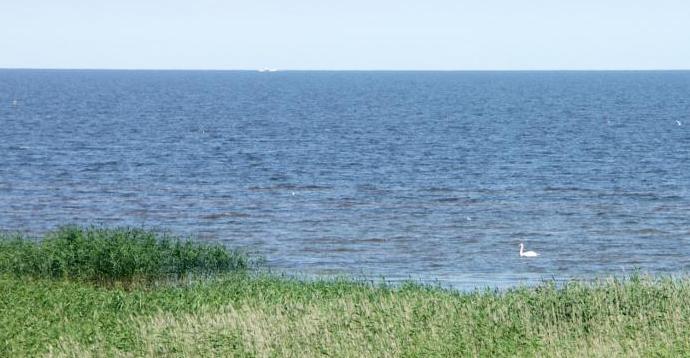
The western part of Lake Peipsi is no less interesting for travelers. The shores in this area have their own unique outlines. Calm bays are combined with steep headlands and gentle coastline. These capes are so high that they reach 24 meters. The depth of the lake is 7.5 meters. What is the bottom? It consists mainly of sand, clayey and sandy silt. This is not such a crystal clear body of water as Baikal or Alp lakes, from an aesthetic point of view. Silty precipitation makes the water cloudy. This place also did not go unnoticed by anglers. The vast waters are rich in a variety of fish. There are burbot, pike perch, salmon and others.
Great Ladoga
How beautiful are the names of the lakes of Russia! For example, the one that captivates us with the beauty of the nature of the North and became a savior during the Second World War. The northern shores are dotted with labyrinths of straits. There are even islands and trees growing on them. The bottom topography systematically increases from the south (51 meters) to the north (230 meters deep).
There are many islets here, which are frozen in the form of sheer bizarre rocks, their height reaches 70 meters. The eastern coast is not as rugged as the western one, where you can find forests and bushes. Lake Ladoga is fed by the waters of thirty-two rivers. The Neva River flows out of it in a full-flowing stream, the length of which reaches 74 kilometers.

By the way, a large number of rainy days are observed here, although the greatest amount of precipitation occurs in the warm season. The winds are quite strong, which leads to roughness on the lake. Wave heights can be up to four meters. The water temperature in the warm season is kept at around +8 degrees Celsius.
Caspian Sea-Lake
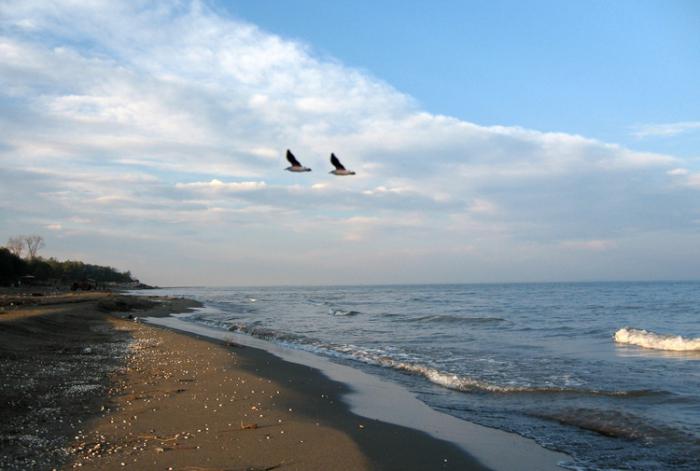
This is not only the largest lake in the world, but also quite deep. Although scientifically it is considered to be the sea. Deep lakes Russia is mysterious and interesting for the traveler in its own way. In the northern part, the depth is shallow - only 5 meters. In the middle it is already getting deeper - 20 meters. South part The deepest of the Caspian Sea reaches 1025.
This sea or lake is unevenly salty. In places where the river mouths are located, the water is more fresh. The water level in the lake is 25 meters below the ocean. There are such big cities like Baku, Makhachkala. The climate is sharply continental, therefore low temperatures in winter and quite high in summer. The large Urals and Volga flow into the Caspian Sea.
Salt lake Chany
There are also salt lakes in Russia, for example Chany. It stretched out in Novosibirsk region and refers to drainless. The word "vats" in translation from the Turkic means "big vessel". Already in October, the lake is covered with ice and thaws only in May. Although its waters in summer warm up to 28 degrees Celsius. The lake area always fluctuates and reaches 2000 square meters. It is not very deep - only 2 meters is the average. On the banks, which are very indented, there are thickets of reeds, reeds, various bushes and sedges.
What else is remarkable about Lake Chany? On the water surface, you can count up to 70 islets, some of them are not only large, but also represent amazing landscapes, have a great variety of plants and rare species of animals. Salt lakes of Russia differ in varying degrees of salinity. Vats are lightly salted, as the main food is melted snow. Lake weather - reflection continental climate... In winter, the snow cover can be up to 30 cm in height.
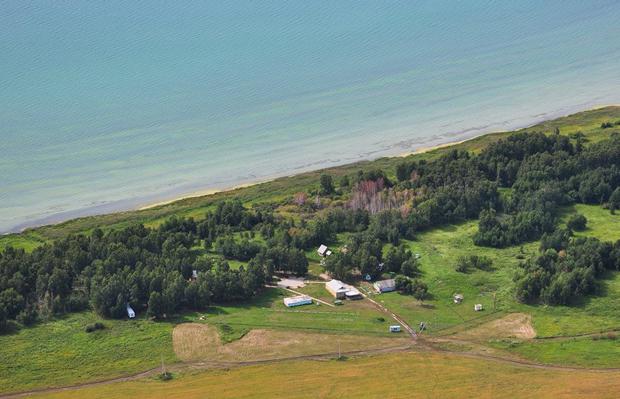
For tourists, there are many recreation centers, there are corners where you can fish. Those who prefer boating should be careful - there is often a storm here. Chany is also considered a mysterious, and according to some stories, an anomalous place. There is a legend that a strange animal of huge size is found here, which harms people and livestock.
Kuril Lake - volcanic beauty
This beautiful creation of nature is located in the very south of the Kamchatka Peninsula and is considered freshwater. The maximum depth reaches 306 meters, so it can be safely attributed to deep-water. Some of the islands that can be found on the surface are peculiar volcanic domes that have risen from the bottom as a result of squeezing out magma.
Such lakes on the territory of Russia are of particular value, therefore the Kuril Lake is included in the UNESCO heritage list. There are even those called "Kuril Springs". Their temperature reaches 45 degrees Celsius.
Cold inaccessibility of Lake Taimyr
it unique lake in area it can be compared only with Baikal. It is considered the northernmost on the planet. What is unusual for a traveler to find here? Characteristic not only cold beauty and greatness, but also the fact that here the water is constantly changing its level. The lake is located in the Krasnoyarsk Territory beyond the Arctic Circle on the peninsula of the same name in the tundra.
We can say that local waters are covered with ice all year round. The deepest is 26 meters. The water temperature in summer does not rise above 8 degrees Celsius, and in winter it drops to zero. The ice can be up to three meters thick. Oddly enough, there are fish in the waters of Taimyr - whitefish, muksun, boil, vendace.
Moraine lakes of Russia. Seliger
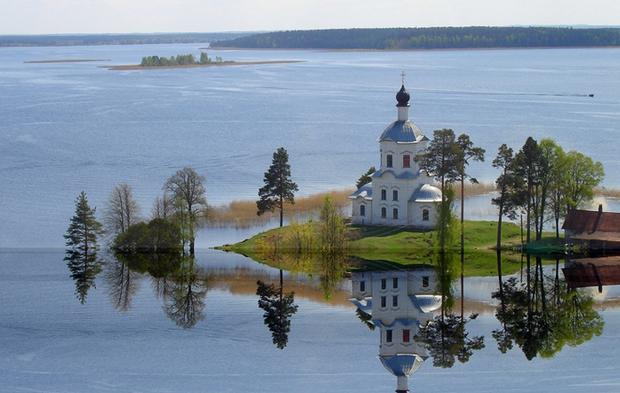
Forests, swamps, cozy coves - all this is the surrounding area of Lake Seliger. It is located in the Tver and Novgorod regions. The landscapes in this area are predominantly hilly, and in some places plains predominate. The natural beaches contrast with the steep banks covered with pine trees. There are about 160 medium and small islets on the lake. The surface is covered with ice during the cold season and is opened only in May. All lakes in Russia are accompanied by unique vegetation. Seliger has not only coniferous trees, but also oaks, bird cherry, mountain ash.
What are moraine lakes in general? These are very picturesque corners of nature, their amazing beauty and unusual origin are simply amazing. Moraine-type lakes in Russia are the so-called "depressions" or "closed basins", which appeared many years ago as a result of the melting of blocks of ice, therefore they are also called "glacial". They can be found only in the north and northwest of Russia. They are rarely large and deep. Usually their average depth does not exceed 10 meters, the banks are usually heavily indented. The largest of those reservoirs that can be attributed to moraine are Chudsko-Pskovskoe, Seliger, Ilmen, which was once called the Slovenian Sea among the Slavs.
Conclusion
As we can see, Russia is a land of lakes that will surely please even the most sophisticated traveler.

